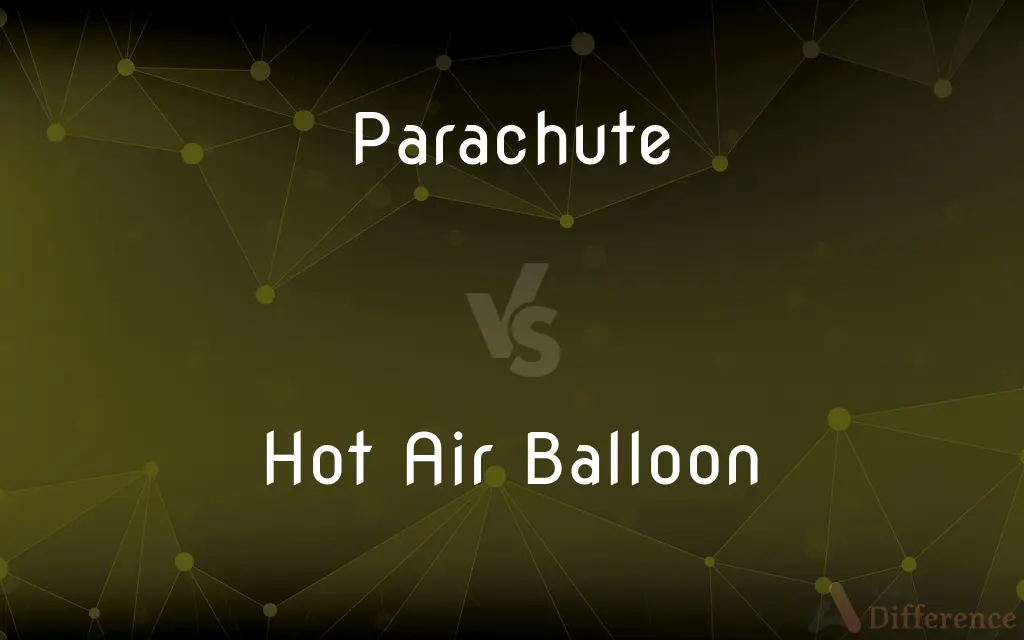Parachute vs. Hot Air Balloon — What's the Difference?
By Tayyaba Rehman — Published on November 11, 2023
Parachute is a device to slow descent through the air, used when jumping from an aircraft. Hot Air Balloon is a large bag filled with hot air to float and fly, steered by a gondola below.

Difference Between Parachute and Hot Air Balloon
Table of Contents
ADVERTISEMENT
Key Differences
The Parachute and Hot Air Balloon are both devices that utilize air to perform their primary functions, but they have distinct purposes and operations. A Parachute is designed primarily to allow a safe descent from high altitudes, such as when jumping from an airplane. It achieves this by creating drag, resisting rapid descent and ensuring a relatively smooth landing. On the other hand, a Hot Air Balloon is constructed for the purpose of leisurely floating and navigating through the sky. It operates on the principle that hot air rises; heating the air inside the balloon causes it to ascend.
While a Parachute is typically made of lightweight and strong materials like nylon, designed to be packed compactly and then deployed in the air, a Hot Air Balloon consists of a large fabric envelope, a burner, and a gondola (or basket) that carries passengers. When activated, the Parachute unfurls and catches the air, slowing the descent of the person or object attached to it. Conversely, the Hot Air Balloon relies on the burner to heat the air inside, making it less dense than the surrounding cooler air, causing it to rise.
The experience of using a Parachute versus a Hot Air Balloon is quite different. Using a Parachute often involves a sensation of freefall before the chute is deployed, followed by a gentle float down. With a Hot Air Balloon, passengers experience a tranquil ascent and a peaceful glide through the air, with the possibility of navigating to different altitudes by adjusting the heat.
Furthermore, the context in which one might encounter a Parachute versus a Hot Air Balloon varies. Parachutes are often linked with extreme sports, military operations, and emergency situations. Hot Air Balloons, on the other hand, are associated with leisurely activities, sightseeing, and festivals.
In summary, while both the Parachute and the Hot Air Balloon interact with air to function, they serve different purposes. The Parachute is for controlled descents, while the Hot Air Balloon is for leisurely ascents and navigation.
ADVERTISEMENT
Comparison Chart
Primary Function
Controlled descent
Floating and navigation
Operational Principle
Drag/resistance
Hot air rises
Typical Use
Skydiving, emergencies
Sightseeing, festivals
Main Components
Fabric canopy, cords
Fabric envelope, burner, gondola
Experience
Freefall then float
Tranquil ascent and float
Compare with Definitions
Parachute
Fabric equipment used in skydiving to resist rapid descent.
The thrill-seeker always checked her Parachute before every jump.
Hot Air Balloon
A large bag that floats by heating the air inside it.
We watched the Hot Air Balloon rise at dawn.
Parachute
A safety apparatus that employs air resistance.
In an emergency, pilots might need to use a Parachute.
Hot Air Balloon
A vessel for aerial navigation using a burner and fabric envelope.
The Hot Air Balloon carried them across the valley.
Parachute
A device that slows the descent of a person or object from the sky.
He jumped from the plane, relying on his Parachute for a safe landing.
Hot Air Balloon
An airborne craft popular for sightseeing and festivals.
The festival featured dozens of colorful Hot Air Balloons.
Parachute
An instrument for airborne activities that decreases speed.
The cargo was dropped with a Parachute to ensure it didn't break.
Hot Air Balloon
A mode of transport that provides a serene skyward journey.
The couple celebrated their anniversary in a Hot Air Balloon.
Parachute
A canopy that unfurls to ensure a controlled fall.
The Parachute opened beautifully against the blue sky.
Hot Air Balloon
A floating device operated by adjusting internal air temperature.
Adjusting the flame, they descended in the Hot Air Balloon.
Parachute
An apparatus used to retard free fall from an aircraft, consisting of a light, usually hemispherical canopy attached by cords to a harness and worn or stored folded until deployed in descent.
Parachute
Any of various similar unpowered devices that are used for retarding free-speeding or free-falling motion.
Parachute
To drop (supplies or troops, for example) by means of a parachute.
Parachute
To descend by means of a parachute.
Parachute
(aviation) A device, generally constructed from fabric, that is designed to employ air resistance to control the fall of an object or person, causing them to float instead of falling.
Parachute
(zoology) A web or fold of skin extending between the legs of gliding mammals, such as the flying squirrel and colugo.
Parachute
(BDSM) A small collar which fastens around the scrotum and from which weights can be hung.
Parachute
A piece of cloth used in physical education often colorful and surrounded by handles.
Parachute
(intransitive) To jump, fall, descend, etc. using such a device.
Parachute
(transitive) To introduce into a place using such a device.
The soldiers were parachuted behind enemy lines.
Parachute
(transitive) To place (somebody) in an organisation in a position of authority without their having previous experience there; used with in or into.
Parachute
A device made of a piece of cloth, usually silk, attached to multiple chords fastened to a harness; when attached to a person or object falling through the air, it opens from a folded configuration into an umbrella-shaped form, thus slowing the rate of descent so that a safe descent and landing may be made through the air from an airplane, balloon, or other high point. It is commonly used for descending to the ground from a flying airplane, as for military operations (as of airborne troops) or in an emergency, or for sport. In the case of use as a sport, the descent from an airplane by parachute is called sky diving. Some older versions of parachute were more rigid, and were shaped somewhat in the form of an umbrella.
Parachute
A web or fold of skin which extends between the legs of certain mammals, as the flying squirrels, colugo, and phalangister.
Parachute
TO descend to th ground from an airplane or other high place using a parachute; as, when the plane stalled, he parachuted safely to the ground.
Parachute
Rescue equipment consisting of a device that fills with air and retards your fall
Parachute
Jump from an airplane and descend with a parachute
Common Curiosities
Do both Parachute and Hot Air Balloon rely on air to function?
Yes, Parachute uses air resistance for descent, and Hot Air Balloon uses heated air for ascent.
Are there risks associated with both Parachute jumping and Hot Air Balloon rides?
Yes, both activities have inherent risks, but with proper precautions and training, they can be enjoyed safely.
How do you make a Hot Air Balloon rise and fall?
By adjusting the temperature of the air inside using the burner; heating to rise and cooling to descend.
How long can you stay airborne in a Hot Air Balloon?
Typically a few hours, but it depends on fuel and weather conditions.
Is a Parachute used for ascent?
No, a Parachute is designed for controlled descent, whereas a Hot Air Balloon is for ascent and floating.
How high can a Parachute jumper jump from?
It varies, but skydivers commonly jump from altitudes between 10,000 and 15,000 feet.
Are Hot Air Balloons used for sports like Parachutes?
While there are competitive ballooning events, Hot Air Balloons are primarily recreational, whereas Parachutes are often used in extreme sports.
How does one learn to use a Parachute?
Through skydiving schools and under the guidance of experienced instructors.
Can a Parachute be used in emergencies in a Hot Air Balloon?
While uncommon, some Hot Air Balloons may have Parachutes for emergency descents.
Are there different types of Hot Air Balloons?
Yes, there are various shapes, sizes, and designs, often made for specific purposes or events.
Is the fabric of a Parachute similar to a Hot Air Balloon?
Both use strong, lightweight fabrics, but they differ in design and purpose.
Can Parachutes be used more than once?
Yes, with proper inspection and repacking, Parachutes can be reused multiple times.
Can you steer a Parachute like a Hot Air Balloon?
While you can control the direction of a Parachute to some extent, a Hot Air Balloon offers more navigation capability.
How do you land a Hot Air Balloon?
The pilot cools the air inside to descend and looks for a safe and open landing spot.
Is the sensation of using a Parachute similar to a Hot Air Balloon ride?
No, Parachute jumping involves an initial freefall and then floating, whereas a Hot Air Balloon provides a calm and steady floating experience.
Share Your Discovery

Previous Comparison
IFSC Code vs. BSR Code
Next Comparison
Amino Acid vs. NucleotideAuthor Spotlight
Written by
Tayyaba RehmanTayyaba Rehman is a distinguished writer, currently serving as a primary contributor to askdifference.com. As a researcher in semantics and etymology, Tayyaba's passion for the complexity of languages and their distinctions has found a perfect home on the platform. Tayyaba delves into the intricacies of language, distinguishing between commonly confused words and phrases, thereby providing clarity for readers worldwide.











































